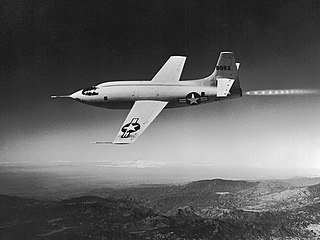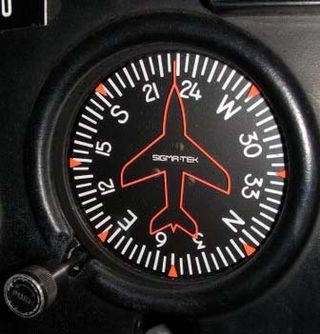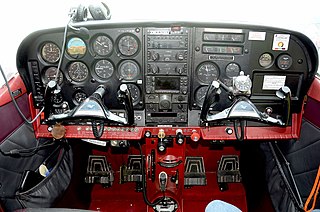Related Research Articles

Avionics are the electronic systems used on aircraft. Avionic systems include communications, navigation, the display and management of multiple systems, and the hundreds of systems that are fitted to aircraft to perform individual functions. These can be as simple as a searchlight for a police helicopter or as complicated as the tactical system for an airborne early warning platform.

A hot air balloon is a lighter-than-air aircraft consisting of a bag, called an envelope, which contains heated air. Suspended beneath is a gondola or wicker basket, which carries passengers and a source of heat, in most cases an open flame caused by burning liquid propane. The heated air inside the envelope makes it buoyant, since it has a lower density than the colder air outside the envelope. As with all aircraft, hot air balloons cannot fly beyond the atmosphere. The envelope does not have to be sealed at the bottom, since the air inside the envelope is at about the same pressure as the surrounding air. In modern sport balloons the envelope is generally made from nylon fabric, and the inlet of the balloon is made from a fire-resistant material such as Nomex. Modern balloons have been made in many shapes, such as rocket ships and the shapes of various commercial products, though the traditional shape is used for most non-commercial and many commercial applications.

Air Canada Flight 143, commonly known as the Gimli Glider, was a Canadian scheduled domestic passenger flight between Montreal and Edmonton that ran out of fuel on Saturday, July 23, 1983, at an altitude of 41,000 feet (12,500 m), midway through the flight. The flight crew successfully glided the Boeing 767 to an emergency landing at a former Royal Canadian Air Force base in Gimli, Manitoba, which had been converted to a racetrack, Gimli Motorsports Park. It resulted in no serious injuries to passengers or persons on the ground, and only minor damage to the aircraft. The aircraft was repaired and remained in service until its retirement in 2008. This unusual aviation incident earned the aircraft the nickname "Gimli Glider."

Avgas is an aviation fuel used in aircraft with spark-ignited internal combustion engines. Avgas is distinguished from conventional gasoline (petrol) used in motor vehicles, which is termed mogas in an aviation context. Unlike motor gasoline, which has been formulated without lead since the 1970s to allow the use of catalytic converters for pollution reduction, the most commonly used grades of avgas still contain tetraethyl lead, a toxic substance used to prevent engine knocking. There are ongoing efforts to reduce or eliminate the use of lead in aviation gasoline.

The Bell X-1 is a rocket engine–powered aircraft, designated originally as the XS-1, and was a joint National Advisory Committee for Aeronautics–U.S. Army Air Forces–U.S. Air Force supersonic research project built by Bell Aircraft. Conceived during 1944 and designed and built in 1945, it achieved a speed of nearly 1,000 miles per hour in 1948. A derivative of this same design, the Bell X-1A, having greater fuel capacity and hence longer rocket burning time, exceeded 1,600 miles per hour in 1954. The X-1 aircraft #46-062, nicknamed Glamorous Glennis and flown by Chuck Yeager, was the first piloted airplane to exceed the speed of sound in level flight and was the first of the X-planes, a series of American experimental rocket planes designed for testing new technologies.

The North American X-15 is a hypersonic rocket-powered aircraft operated by the United States Air Force and the National Aeronautics and Space Administration as part of the X-plane series of experimental aircraft. The X-15 set speed and altitude records in the 1960s, crossing the edge of outer space and returning with valuable data used in aircraft and spacecraft design. The X-15's highest speed, 4,520 miles per hour, was achieved on 3 October 1967, when William J. Knight flew at Mach 6.7 at an altitude of 102,100 feet (31,120 m), or 19.34 miles. This set the official world record for the highest speed ever recorded by a crewed, powered aircraft, which remains unbroken.

The heading indicator (HI), also known as a directional gyro (DG) or direction indicator (DI), is a flight instrument used in an aircraft to inform the pilot of the aircraft's heading.

Aircraft engine controls provide a means for the pilot to control and monitor the operation of the aircraft's powerplant. This article describes controls used with a basic internal-combustion engine driving a propeller. Some optional or more advanced configurations are described at the end of the article. Jet turbine engines use different operating principles and have their own sets of controls and sensors.

Air Transat Flight 236 was a transatlantic flight bound for Lisbon, Portugal, from Toronto, Canada, that lost all engine power while flying over the Atlantic Ocean on August 24, 2001. The Airbus A330 ran out of fuel because of a fuel leak caused by improper maintenance. Captain Robert Piché, 48, an experienced glider pilot, and First Officer Dirk DeJager, 28, glided the plane to a successful emergency landing in the Azores, saving all 306 people on board. Most of the passengers on the flight were Canadians visiting Europe or Portuguese expatriates returning to visit family in Portugal. This was also the longest passenger aircraft glide without engines, gliding for nearly 75 miles or 121 kilometres. Following this unusual aviation accident, this aircraft was nicknamed the "Azores Glider".

The Robinson R44 is a four-seat light helicopter produced by Robinson Helicopter Company since 1992. Based on the company's two-seat Robinson R22, the R44 features hydraulically assisted flight controls. It was first flown on 31 March 1990 and received FAA certification in December 1992, with the first delivery in February 1993.

The Learjet 25 is an American ten-seat, twin-engine, high-speed business jet aircraft manufactured by Learjet. It is a stretched version of the Learjet 24.

American Airlines Flight 157, a Douglas DC-6, departed on November 29, 1949, from New York City bound for Mexico City with 46 passengers and crew. After one engine failed in mid-flight, a series of critical mistakes by the flight crew caused the pilot to lose control of the plane during the final approach to a routine stopover at Love Field in Dallas, Texas. The airliner slid off the runway and struck a parked airplane, a hangar, and a flight school before crashing into a business across from the airport. 26 passengers and two flight attendants died. The pilot, co-pilot, flight engineer, and 15 passengers survived.

British Airways Flight 009, sometimes referred to by its callsign Speedbird 9 or as the Jakarta incident, was a scheduled British Airways flight from London Heathrow to Auckland, with stops in Bombay, Kuala Lumpur, Perth, and Melbourne.
GUMPS is an acronym widely used by retractable gear aircraft pilots as a mental checklist to ensure nothing critical has been forgotten before landing. Its popularity is widespread, appearing in flight student curricula, FAA publications and aviation magazines.

A transponder is an electronic device that produces a response when it receives a radio-frequency interrogation. Aircraft have transponders to assist in identifying them on air traffic control radar. Collision avoidance systems have been developed to use transponder transmissions as a means of detecting aircraft at risk of colliding with each other.

The Bristol Type 138 High Altitude Monoplane was a British high-altitude single-engine, low-wing monoplane research aircraft developed and produced by the Bristol Aeroplane Company during the 1930s. It set nine world altitude records, with the maximum altitude achieved being 53,937 ft (16,440 m) on 30 June 1937, during a 2¼-hour flight.

British Airways Flight 38 was a scheduled international passenger flight from Beijing Capital International Airport in Beijing, China, to London Heathrow Airport in London, United Kingdom, an 8,100-kilometre trip. On 17 January 2008, the Boeing 777-200ER aircraft operating the flight crashed just short of the runway while landing at Heathrow. No fatalities occurred; of the 152 people on board, 47 sustained injuries, one serious. It was the first time in the aircraft type's history that a Boeing 777 was declared a hull loss, and subsequently written off.

On 4 September 2000, a chartered Beechcraft 200 Super King Air departed Perth for a flight to the mining town of Leonora, Western Australia. The aircraft crashed near Burketown, Queensland, Australia, resulting in the deaths of all eight occupants. During the flight, the aircraft climbed above its assigned altitude. When air traffic control (ATC) contacted the pilot, the pilot's speech had become significantly impaired, and he was unable to respond to instructions. Three aircraft intercepted the Beechcraft, but were unable to make radio contact. The aircraft continued flying on a straight north-easterly heading for five hours, before exhausting its fuel and crashing 40 mi (65 km) south-east of Burketown. The crash became known in the media as the "ghost flight".
An aircraft fuel system allows the crew to pump, manage, and deliver aviation fuel to the propulsion system and auxiliary power unit (APU) of an aircraft. Fuel systems differ greatly due to different performance of the aircraft in which they are installed. A single-engine piston aircraft has a simple fuel system; a tanker, in addition to managing its own fuel, can also provide fuel to other aircraft.

Dana Air Flight 0992 was a scheduled Nigerian domestic passenger flight from Abuja to Lagos, Nigeria. On 3 June 2012, the McDonnell Douglas MD-83 aircraft serving the route suffered a dual-engine failure during its approach to Lagos. It failed to reach its intended destination and crashed onto buildings, killing all 153 people on board and six on the ground. With 159 deaths, it remains as the deadliest commercial airliner crash in Nigerian history since the Kano air disaster in 1973.
References
- ↑ Aircraft & Aerospace. Peter Isaacson Publications Pty. Limited. 1989. Retrieved 17 February 2022.
- ↑ Hardie, James (19 March 2015). The Naked Pilot: How a Scotsman Crashed a Messerschmitt on North Weald. AuthorHouse. ISBN 978-1-5049-3941-6 . Retrieved 17 February 2022.
- ↑ LASORS 2010: the guide for pilots. Civil Aviation Authority: Personnel Licensing Department. 9 December 2010. ISBN 978-0-11-792219-8 . Retrieved 17 February 2022.
- ↑ Masauli, S. E. (1993). My Life & My Aeroplanes. S.E. Masauli. Retrieved 17 February 2022.